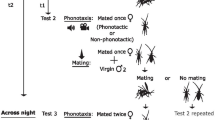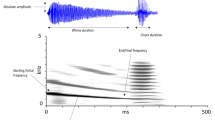Abstract
We studied the phonotactic response of Alytes cisternasii females at different reproductive stages (before and after oviposition) toward two male call characteristics (call rate and frequency) differing in variability, as well as in the strength of female preference. We measured female phonotactic response over several repetitions by means of the frequency of selection of the population-preferred alternative, consistency of choice, frequency of reciprocal calling activity, frequency of null trials, and average approach time. Our results showed that female mating preferences in A. cisternasii are highly influenced by the variability of male call characteristics, while only female motivation is related to reproductive stage.

Similar content being viewed by others
References
Andersson M (1994) Sexual selection. Princeton University Press, Princeton, NJ
Bosch J, Márquez R (1996) Acoustic competition in male midwife toads Alytes obstetricans and A. cisternasii: response to neighbour size and calling rate. Implications for female choice. Ethology 102:841–855
Bosch J, Rand AS, Ryan MJ (2000) Signal variation and call preferences for the whine frequency in the túngara frog, Physalaemus pustulosus. Behav Ecol Sociobiol 49:62–66
Bosch J, Márquez R, Boyero L (2003) Behavioural patterns, preference and motivation of female midwife toads during phonotaxis tests. J Ethol 21:61–66
Burley N, Moran N (1979) The significance of age and reproductive experience in the mate preferences of feral pigeons, Columba livia. Anim Behav 27:686–698
Bush SL (1993) Courtship and male parental care in the Mallorcan midwife toad (Alytes muletensis). PhD Thesis, University of East Anglia
Bush S, Bell DJ (1997) Courtship and female competition in the Majorcan midwife toad, Alytes muletensis. Ethology 103:292–303
Crespo EG (1982) Contribuçao para o conhecimento da biología das espécies Ibéricas de Alytes, Alytes obstetricans Boscai (Lataste 1879) e Alytes cisternasii (Boscá 1879) (Amphibia Discoglossidae). Ovos, posturas (Epocas de reprodução). Arq Museo Bocage Ser A 1:453–466
Duellman WE, Trueb L (1984) Biology of amphibians. Johns Hopkins University Press, Baltimore, Md
Dyson ML, Bush SL, Halliday T (1998) Phonotaxis by female Majorcan midwife toads, Alytes muletensis. Behaviour 135:213–230
Gerhardt HC (1991) Female mate choice in treefrogs: static and dynamic acoustic criteria. Anim Behav 42:615–636
Grafe TU, Spieler M, Köning B (1999) Soziobiologische Erklärungsansätze des Verhaltens von Amphibien und Reptilien: aktuelle Theorien und offene Fragen. Z Feldherpetol 6:1–42
Halliday TR (1998) Sperm competition in amphibians. In: Birkhead TR, Møller AP (ed) Sperm competition and sexual selection. Academic, London, pp 456–502
Jennions MD, Petrie M (1997) Variation in mate choice and mating preferences: a review of causes and consequences. Biol Rev 72:283–327
Jennions MD, Backwell PR, Passmore NI (1995) Repeatability of mate choice: the effect of size in the African painted reed frog, Hyperolius marmoratus. Anim Behav 49:181–186
Jones KM, Monaghan P, Nager RG (2001) Male mate choice and female fecundity in zebra finches. Anim Behav 62:1021–1026
Jørgensen CB (1992) Growth and reproduction. In: Feder ME, Burggren WW (ed) Environmental physiology of the amphibians. University of Chicago Press, Chicago, pp 439–466
Lea J, Halliday T, Dyson M (2000) Reproductive stage and history affect the phonotactic preferences of male midwife toads, Alytes muletensis. Anim Behav 60:423–427
Lea J, Dyson M, Halliday T (2001) Calling by male midwife toads stimulates female to maintain reproductive condition. Anim Behav 61:373–377
Márquez R (1990) The mating systems of the midwife toads. PhD Thesis, University of Chicago, Illinois
Márquez R (1995) Female choice in the midwife toads (Alytes obstetricans and A. cisternasii). Behaviour 132:151–161
Márquez R, Bosch J (1995) Advertisement calls of the midwife toads Alytes (Amphibia, Anura, Discoglossidae) in continental Spain. J Zool Syst Evol Res 33:185–192
Márquez R, Verrell P (1991) The courtship and mating of the Iberian midwife toad, Alytes cisternasii (Amphibia, Anura, Discoglossidae). J Zool 225:125–139
Murphy CG, Gerhardt HC (1996) Evaluating the design of mate-choice experiments: the effect of amplexus on mate choice by female barking treefrogs, Hyla gratiosa. Anim Behav 51:881–890
Perrill SA, Daniel RE (1983) Multiple egg clutches in Hyla regilla, H. cinerea and H. gratiosa. Copeia 1983:513–516
Reading CJ, Clarke RT (1988) Multiple clutches, egg mortality and mate choice in the mid-wife toad, Alytes obstetricans. Amphibia-Reptilia 9:357–364
Reyer HU, Gerhard F, Som C (1999) Cryptic female choice: frogs reduce clutch size when amplexed by undesired males. Proc R Soc Lond B 266:2101–2107
Roy D, Borah B, Sarma A (1995) Analysis and significance of female reciprocal call in frogs. Curr Sci India 69:265–270
Ruscio HG, Adkins-Regan E (2003) Effect of female brooding behaviour on male mate choice in Japanese quail, Coturnix japonica. Anim Behav 65:397–403
Verrell PA (1995) Males choose larger females as mates in the salamander Desmognathus santeetlah. Ethology 99:162–171
Verrell PA, Brown LE (1993) Competition among females for mates in a species with male parental care, the midwife toad Alytes obstetricans. Ethology 93:247–257
Acknowledgements
We thank W. Wilczynski, E. Albert, I. Martínez-Solano, M. García-París and three anonymous reviewers for constructive remarks on the manuscript. The first author is supported by the Ramón y Cajal program from the Ministerio de Ciencia y Tecnología (Spain). The second author is supported by a postdoctor grant from the MEC (Spain) cofinanced by the European Social Fund. Partial funding was provided by project BOS2003-01413 (MCYT) (PI: J. Bosch). The Consejería de Medio Ambiente of Junta de Extremadura kindly extended permits for fieldwork. All animal experimentation was conducted in accordance with the legal standards of Spain.
Author information
Authors and Affiliations
Corresponding author
Additional information
Communicated by T. Czeschlik
Rights and permissions
About this article
Cite this article
Bosch, J., Boyero, L. Reproductive stage and phonotactic preferences of female midwife toads (Alytes cisternasii). Behav Ecol Sociobiol 55, 251–256 (2004). https://doi.org/10.1007/s00265-003-0699-8
Received:
Revised:
Accepted:
Published:
Issue Date:
DOI: https://doi.org/10.1007/s00265-003-0699-8




